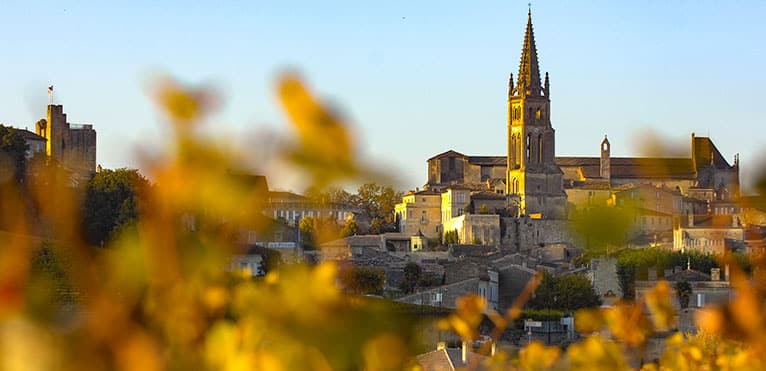
Contents
Cadillac is a sweet white wine with the dual AOC-AOP appellation. It is produced in a total of 21 communes surrounding the village of Cadillac, as well as in the commune of Cadillac itself. This group of communes borders the Loupiac and Sainte-Croix-du-Mont appellations in the Entre-deux-Mers region, at the very heart of the Bordeaux vineyards.
From Premières-côtes-de-Bordeaux… to the Cadillac appellation
The Cadillac appellation was created in 1973. Previously, Cadillac wines were part of another appellation, Premières-Côtes-de-Bordeaux. It was the selection of the best parcels of Premières-côtes-de-Bordeaux to be grouped together under a single appellation that gave rise to the Cadillac appellation we know today.
Concerning the way the vineyard is managed, the minimum planting density is 4500 vines per hectare. In addition, the alcoholic strength of the wine must be between 12.5% volume minimum and 19% volume maximum. The residual sugar content must be at least 51 grams per liter, which classifies Cadillac as a sweet wine.
The grapes used to make the wine are harvested very ripe, so they are very rich in sugar. Thus, at the start of the harvest, the winemaker must be able to measure a minimum of 255 grams of sugar per liter. Not all sugar is transformed into alcohol: some of it makes up the residual sugar that gives the wine its sweetness.
The Cadillac AOC covers 128 hectares that benefit from the cool mornings.
The Cadillac appellation is located in the Entre-deux-Mers region, on the right bank of the Garonne, thirty kilometers south of the city of Bordeaux. It covers the commune of Cadillac as well as 21 other smaller communes such as Capian, Paillet and Tabanac.
The vines benefit from a temperate oceanic climate, with relatively mild temperatures in winter and no harsh droughts in summer. Located on southern slopes, the vines are exposed to the sun. What’s more, the Garonne and surrounding rivers act as a real thermal regulator. The humidity that emerges on autumn mornings, and which fades during the day, encourages the development of noble rot, caused by a fungus called Botrytis Cinerea. The weather conditions are ideal for the development of sweet wines, thanks to the fungus that thrives in this type of humidity.
The land at the top of the hill is made up of colluvium, a mixture of silts and sandy clays, while the soils closer to the Garonne are covered with sands, gravels and pebbles.
Cadillac is a sweet wine composed mainly of Semillon.
Several traditional grape varieties are included in the Cadillac specifications. The most widely used grape variety is Semillon, which accounts for 70% of the appellation’s vines. This is due to the grape variety’s ability to produce a high concentration of sugar, which is very useful for making sweet wines. Sauvignon Blanc and Sauvignon Gris make up 20% of the total grape varieties, adding a hint of vivacity to the wines. The remaining 10% is Muscadelle, which adds complexity.
Cadillac wines have a beautiful golden color. This color evolves over time, becoming increasingly amber as it ages. Their nose is marked by floral aromas and notes of apricot and lime blossom. On the palate, they reveal notes of candied citrus fruit, vanilla and even honey. These wines are well-balanced, being both sweet and fruity, with a liveliness that leaves a lovely freshness on the palate.
Their ageing potential varies from 2 to 5 years on average. It’s a good idea to let the wine mature a little, as this makes it smoother.
Cadillac throughout the meal
Wines from this appellation are fresh yet sweet, and the resulting balance is perfect! They can be enjoyed with Roquefort appetizers or foie gras accompanied by fig jam. They’re also renowned for pairing perfectly with dried fruit, white meat, fish in sauce or blue-veined cheese. This wine will accompany you throughout your meal. To enjoy it to the full, it should be served at between 6 and 8 degrees Celsius.
The vintage of the millennium in 1990 for AOC Cadillac
Cadillac is distinguished by several remarkable vintages that ensure the quality of wines from this appellation. Indeed, the appellation can boast exceptional vintages in 2009 and 2015, a vintage of the century in 2001, and even a vintage of the millennium in 1990! More recently, Cadillac was classified as an exceptional vintage in 2017.
2 Cadillac estates committed to ecology
Les Carmels estate
The 5-hectare vineyard, which had been planted for several decades, was taken over in 2010 by Yorick and Sophie Lavaud, who decided to cultivate it organically. The latter is treated with herbal teas and purins produced at the Carmels. In the near future, a market garden will be set up on the estate, in addition to the family kitchen garden and large orchard already in existence.
Château Brethous
This family-run business is on a human scale and has a dual objective. The first is ecological, and the second is to ensure that the wine produced is of the highest quality. The first certified organic cuvée dates back to 2012, and the Mallié-Verdier family crafts great wines whose motto is to combine structure, charm and elegance.
The particular beauty of this Cadillac estate lies in the fact that it boasts an attractive 18th-century longère overlooking the Garonne River.